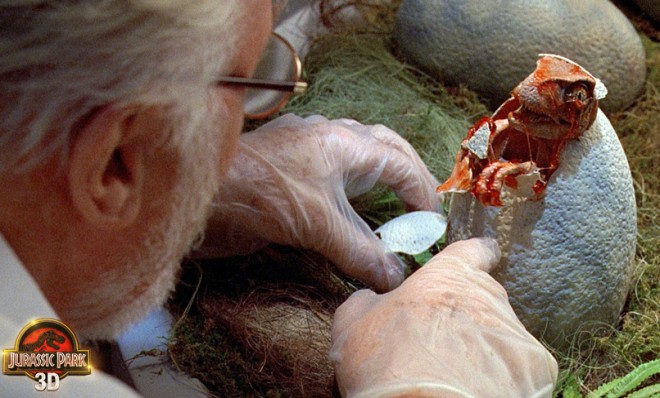Why Jurassic Park was meant to be seen in 3D
Twenty years after its release, Jurassic Park is back on the big screen in 3D — and it's better than ever

If you're looking for a reminder of your old age and impending mortality, here's a sobering fact: Jurassic Park was released almost 20 years ago. And as is the modern custom, as exhibited by the recent re-releases of Titanic and Top Gun, Steven Spielberg's classic blockbuster isn't just coming back to theaters — it's coming back to theaters in 3D. Jurassic Park's 3D makeover is more than just a reason to see the film in theaters again; it's the reason to see it in theaters again. The 3D update is a better version of the film, as posters and TV spots insist: "This is the way it was meant to be seen."
Unsurprisingly, critics are less than thrilled by the claims that Jurassic Park was meant to be seen under the filter of technology that didn't even exist in its current form when the movie was originally filmed. But let's cast aside all the (typically justified) anti-3D biases and ask: What if this really is the way Jurassic Park is meant to be seen? When Jurassic Park hit theaters in 1993, it rode a wave of press that sung its praises for using the most advanced cinema technology of its era — a claim that applies just as equally in 2013 to Jurassic Park 3D.
I'll explain, but, just so you know, this is about to get a bit academic, so hold onto your butts.
The Week
Escape your echo chamber. Get the facts behind the news, plus analysis from multiple perspectives.

Sign up for The Week's Free Newsletters
From our morning news briefing to a weekly Good News Newsletter, get the best of The Week delivered directly to your inbox.
From our morning news briefing to a weekly Good News Newsletter, get the best of The Week delivered directly to your inbox.
In a 1986 essay titled The Cinema of Attractions: Early Film, Its Spectator and The Avant-Garde, film scholar Tom Gunning discussed the visual merits of early film — arguing that some early filmmakers reveled in the idea of what films could show, rather than what they had to say. This observation led him to coin the phrase "the cinema of attractions," which applies to films that offer stimulation that is "purely exhibitionist." While some early filmmakers focused on the narrative possibilities of the medium, others were solely focused on the spectacle of film.
Though Gunning used this observation to explain early avant-garde films, the term is just as useful when discussing the modern Hollywood blockbuster, which represents a kind of hybrid between contemporary narrative film and the cinema of attractions. In its original version, Jurassic Park combined animatronics with cutting-edge animation and digital compositing, and Spielberg's dinosaurs were breathtakingly — and terrifyingly — realistic. Quite simply, Spielberg created the best cinematic spectacle he could with what 1990s technology allowed.
What is more, with Jurassic Park, Spielberg cunningly created a film that's as much about spectacle as it is one. That idea is most visible is in the immortal shot when Dr. Hammond shows Dr. Grant a real, living dinosaur for the first time. The expressions of awe on the characters' faces, as they see the brontosaurus, mirrored the awe of cinema audiences across the globe; we're as speechless as our heroes because Spielberg, like Hammond, has created the ultimate spectacle.
In the 20 years since its release, Jurassic Park has endured as a terrific and powerful film — but that gut-level awe was lost, due to a slew of imitators and the passage of time. Until now. Having seen Jurassic Park 3D earlier this week, I can say with confidence that Universal spared no expense in the 3D conversion. The 3D doesn't add a sense of depth or enrichment of dimension like in Ang Lee's Life of Pi or James Cameron's Avatar — which were both created using 3D technology — but it does give the film such a heightened sense of excitement; enough that it felt like I was watching the movie, which I've probably seen dozens of times since its release, for the first time again. Certain scenes feel like you're closer to the action, and characters rarely interact with each other on different geographic planes (the tell-tale effect of cheaply rendered 3D).
A free daily email with the biggest news stories of the day – and the best features from TheWeek.com
In this version of the movie, Spielberg's dinosaurs are as jaw-droppingly realistic as ever, and in 3D, the action sequences evoke a far more visceral reaction than ever before. 3D might not have been the exact idea Spielberg had in mind when he set out to make Jurassic Park, but he did want to make a film that was the ultimate in technologically advanced cinematic spectacle — and 20 years later, he has succeeded again. Technology — like life — finds a way.
Matt is an arts journalist and freelance writer based in Washington, D.C. He has written about film, music, and pop culture for publications including Washington City Paper, The American Interest, Slant Magazine, DCist, and others. He is a member of the Washington D.C. Film Critics Association.
-
 7 bars with comforting cocktails and great hospitality
7 bars with comforting cocktails and great hospitalitythe week recommends Winter is a fine time for going out and drinking up
-
 7 recipes that meet you wherever you are during winter
7 recipes that meet you wherever you are during winterthe week recommends Low-key January and decadent holiday eating are all accounted for
-
 Nine best TV shows of the year
Nine best TV shows of the yearThe Week Recommends From Adolescence to Amandaland